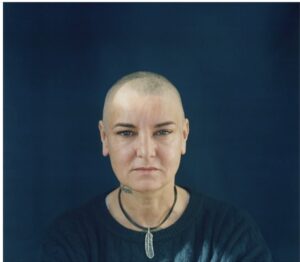
Learning of the death of Sinead O’Connor. I am gutted. Premature death and the history of Ireland take up a big space in my heart.
Oddly enough, I have been talking and writing about Sinead O’Conner for the past few weeks. I’ve been on a deep dive as I create new courses to teach this Fall. Hours writing and reflecting on women, power, aging, our relationship to our body as we work to create healthier and more inclusive cultures had to include her.
When I was 16 years old, Sinead O’Connor seemed to come out of nowhere – shaved head, combat boots and the eyes of a fawn. Non-conformist and roaring, my friends and I were all ears.
We admired her strength and willingness to take on the establishment. We also admired that she was ‘gorgeous” according to cultural standards of the time.
We wanted to be like her. Yet, I didn’t shave my head. I didn’t think I would look as good. Truth hurts.
I am nearly 6 feet tall and have been an athlete my whole life. I am not small. I didn’t have Serena Williams to look up to yet. I worried that if I shaved my head, I would be seen as big, angry, AND unattractive. That felt like a lot of strikes for a 16 yo woman who wanted enough access to power to change the status quo. I wasn’t ready to stand that far apart.
I understood then and now, that most of us do not decide what our culture deems pretty or powerful– but clearly we are in dialogue, we are responding.
How do we respond?
As a teen, I had the privilege to flip the bird to some things while not excluding myself from what my culture valued all together. It was also its own trap door.
How far outside the cultural values did I want to step?
My friends and I protested by refusing a certain kind of femininity around our appearance. I shaved ½ my head, dyed it black and purple. We wore suit jackets with huge shoulder pads and combat boots with short skirts.
What we did was not a brave act. It was a teenage exploration of expression.
Brene Brown’s research lab at UT has conducted sociological studies exploring the cultural sub text in the US for men and women. The message for women clearly is ‘Be pretty, sexy, and all the things, but don’t take up too much space. Be small and pleasing. And act like all you do isn’t work. “
Not unlike Gloria Steinem infiltrating the Playboy Bunny scene, Sinead with her big eyes, brave heart and gorgeous voice was taking on The Catholic Church and other cultural institutions. That was her response to the call.
We were struck by her commitment to the issues, no matter how uncomfortable those truths were. She had our attention.
Would she have gotten as much media exposure if she wasn’t not considered ‘beautiful?’ Doubt it. But did she use the attention and mic for a worthy cause? 100%
My friends and I came of age in the 1980s. To be taken seriously and have the power we wanted, we could not be too feminine.
Fast forward to 2015 – all of us, north easterners from Philadelphia and New York, met up in Charleston, South Carolina for a weekend. One night at a restaurant, I looked around at the very “fem” and ‘girly’ attire of the women and girls around us at the other tables. The aesthetic and cultural dialog about what is pretty or powerful is different in Charleston than where we are from. The contrast was striking.
I asked my friends, “So, why didn’t you go ultra fem? Why did you choose to dress the way you do?”
Each of us was quick to answer. We wanted to be taken seriously, not to be written off as ‘just pretty’ and we did not want to engage in fending off unwanted attention. We dressed accordingly. Making our appearance more ‘masculine.’ That was the currency where we lived and in the subgroup we identified with, Barbie was not our icon at that time.
Now?
We have more power – we can vote, drive, have credit, income, and careers. For some of us having privilege and power opened the possibility to explore what it is like to wear more feminine attire without giving away our power. Is that a good thing?
I think the answer is deeply personal.
For one person exploring ultra-femininity may be empowering, may be a way to reclaim power. For another, it could have the opposite effect, making us feel complicit.
It all depends on how we construct the story of our identity. It all depends on the meaning we make of it.
Our body is fundamental to our experience of identity. Not how just it looks, but primarily how it feels and what it experiences is how your brain creates meaning and story.
We ascribe meaning and create our story in response to felt experiences we have in our cultures. Our brain constructs the personal narrative of our body’s experience– of identity, and power. Not the other way around.
While we are always in relationship to a culture’s values, we get to choose a response and build our own narrative. When we do so, we not only claim our own value for ourselves, sometimes we also change the cultural dialogue.
Having options is the heart of the matter.
Thanks to the many trailblazers for being brave enough and determined enough to use their power for the good of all, to make space and create more options.
Thanks Sinead. Rest in Peace.
Astra 

